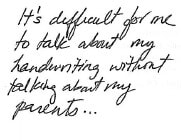Teaching Cursive Writing at Home

In a society that continues accelerated integration with technology, a heated debate has surfaced about whether or not K-12 teachers and schools should be required to teach cursive writing. Many believe cursive writing, also called script or longhand, is an art that should be preserved, while others think time in classrooms should be spent focusing on more applicable skills, like keyboarding, in the current technology-driven era.
Homeschools are in the unique position to teach however they see fit. Nevertheless, home educators must still question if cursive penmanship is necessary, useful and worth the time.
Common Core State Standards, which were adopted by most states in 2010, don’t require schools to teach the skill, although they do require “keyboarding skills.” This hasn’t stopped states like Alabama, Louisiana, and a handful of others from passing laws that require their state educators to teach the practice.
Although not all states are making it a necessary skill to teach, some parents might still want to teach their children the slowly vanishing art of penmanship.
The Value of Cursive Writing
Sure, knowing how to legibly sign one’s name is a handy skill. But the real value of knowing how to write in cursive is the speed increase when writing by hand. There are many scenarios when students are required to write by hand, namely timed essays, tests, and some note taking.
Cursive writing is a visually appealing way to write, and some say it increases creativity and makes it easier for someone to express themselves in writing. Additionally, research shows a link between letter printing and brain activation.
It isn’t just about the writing aspect, either. Without learning cursive, many people will have trouble if they end up in a situation where they must read it.
How to Teach Cursive Writing at Home
 Luckily, there are many resources available for parents who choose to teach their children cursive writing at home. From online instruction to printable worksheets, and even apps for smartphones and tablets, the process of teaching your child cursive writing at home can be made easy.
Luckily, there are many resources available for parents who choose to teach their children cursive writing at home. From online instruction to printable worksheets, and even apps for smartphones and tablets, the process of teaching your child cursive writing at home can be made easy.
When to start
Sources recommend teaching cursive writing during the third grade, or when a child is around 8 years old. Of course, this age is flexible. If your child has already mastered writing print on their own without just copying letters from one line to the next, and their motor skills are more developed, they are likely ready to start learning cursive.
Order matters
Did you know that there are different recommended orders of teaching how to write the alphabet? The order is used for both print and cursive writing, and each order is different.
Handwriting Without Tears (HWT), a company that develops materials and a curriculum used by over three million students to teach handwriting in an easy, developmentally appropriate and inclusive way, recommends teaching lowercase letters first in order to help children learn cursive skills in an easy and efficient way.
HWT says to start with lowercase letters that are similar in style to print letters before moving to the letters that look different. Then, move on to capital letters and follow the same idea. You can find the specific recommended order on HWT’s website.
“Loops and Other Groups: A Kinesthetic Writing System,” uses a different teaching order. Developed by Mary D. Benbow, the system uses the similar form or movement patterns of both upper and lower case letters and divides them into groups. These four groups are “the clock climbers,” (a, d, g, q, c), “kite strings,” (i, u, w, t, j, p, r, s, o), “loop group,” (h, k b, f, l, e) and “hills and valleys (n, m, v, y, x, z).
Free worksheets

Practice makes perfect, right? Get some printable worksheets and have your child or children start practicing cursive letters.
K5 Learning, an online reading and math program for kindergarten to fifth-grade students, offers free printable worksheets that can be used to practice writing cursive letters, words and sentences. The website offers these sheets in order, starting with just the letters, before working to make the letters into words, sentences and finally complete passages.
Kid Zone is another source that offers free printable worksheets, and it also follows a specific order when teaching or learning cursive similar to the Loops and Other Groups approach.
This order also focuses on the actual style of writing the letters, beginning with “round” letters (a, d, g q, c), then “climb ‘n’ slide” letters (i, u, w, t), “loopy” letters (e, l, h, k, b f, j), “lumpy” letters (n, m, v, x), and finally “mix ‘n’ match” (p, r, s, o, y, z).
Not surprisingly, there are also a wide range of cursive worksheets available on Pinterest too.
There’s an app for that!
And of course, in this digital age, there’s no shortage of apps available for smartphones and tablets that can aid your child in their pursuit to write in cursive.
“Cursive Writing Wizard,” received an 8.9 rating by AppCrawlr. There is a free version, but the complete version is available for $4.99 in the Apple Store. The app teaches cursive writing through a fun system specifically designed to maintain motivation, and it's customizable to fit each user’s needs regarding letter size and difficulty.
“ABCs Kids Tracing Cursive,” also received an 8.9 rating by AppCrawlr and is available for free in the Google Play Store. This app is created in flashcard form and it allows users to trace and then erase each letter of the alphabet for practice. But, this app does not test for accuracy.
“Zaner-Bloser Handwriting,” an app created by Zaner-Bloser, Inc., one of the largest handwriting curriculum publishers in the nation, is available for $1.99 in the Apple Store. The interactive app is better for those who need more guided instruction, offering both video animation and instructional support, among other features.
Summing It Up: Find what works best
Children learn differently and there’s no way to tell which approach to teaching cursive writing at home will work best, quickest or easiest. Don’t be afraid to try more than one of the above recommendations as your child learns to see which way works best for them.







I found cursive writing to be very useful in college/university settings. Other than that, I don't really need to take notes quickly or frequently. The usefulness of it really depends on career path I think. Better to prepare your kids than to un-prepare them.
There are thousands of scientific peer-reviewed journal articles revealing the benefits of cursive writing, including benefits for executive functions (frontal lobe development). Why would teachers exclude the cursive writing curriculum?
I'm sure there are many reasons... none of which are justifiable if you're looking at it from the students POV, but that's not really how public schools work.